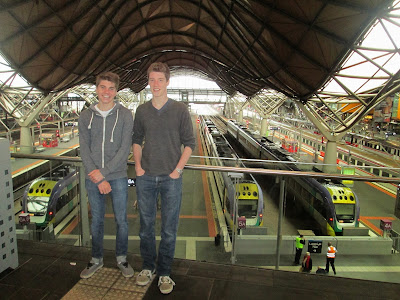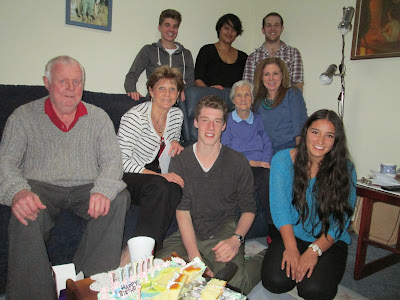One of the many highlights of my recent time in Australia was a visit to Melbourne, home to my older brother Chris, my sister-in-law Cathie, and my four nephews.
Right: With Chris and Cathie – Tuesday, April 8, 2014.
I hadn't seen any of the members of my brother's family since January 2011, so it was great to spend time with them during the five days I was in Melbourne earlier this month. The only disappointment was that I didn't catch up with my nephew Liam, who is currently in Western Australia. But since he's there living his dream of being a commercial pilot, it was a disappointment I can live with!
About the city of Melbourne, Wikipedia notes:
Melbourne is the capital and most populous city in the state of Victoria, and the second most populous city in Australia (4.35 million) after Sydney (4.76 million). It is located on the large natural bay of Port Phillip, with its City Centre situated at the northernmost point of the bay – near to the estuary of the Yarra River. The metropolitan area extends south from the City Centre, along the eastern and western shorelines of Port Phillip, and expands into the hinterlands – toward the Dandenong and Macedon mountain ranges, Mornington Peninsula and Yarra Valley. The City Centre is located in the municipality known as the City of Melbourne, and the metropolis consists of a further 30 municipalities.
Above: My eldest nephew and godson Ryan and his wife Farah. Ryan celebrated his 24th birthday when I was in Melbourne.
Above: My nephews Brendan and Mitchell at Melbourne's Southern Cross Station.
Above: That's Merle, my sister-in-law Cathie's mum, center right. Cathie's next to her while at left are two of Merle's other adult children, Dick and Trish. Also pictured are Ryan, Farah, Mitch and Brendan, and, at right, Mitch's girlfriend Charmaine.
Above: Cathie with the family's two dogs Foxy and Poppy.
Left: With Foxy and Poppy.
Above: Monash Gallery of Art (MGA), the "home of Australian photography" – Tuesday, April 8, 2014.
When Cathie, Mitch and Brendan & I visited the gallery, its featured exhibition was The Rennie Ellis Show.
Notes the MGA's website:
The photographer Rennie Ellis (1940–2003) was a key figure in Australian visual culture. Ellis is best remembered for his effervescent observations of Australian life during the 1970s–90s, including his now iconic book Life is a Beach. Although invariably inflected with his own personality and wit, the thousands of social documentary photographs taken by Ellis during this period now form an important historical record.
The Rennie Ellis Show highlights some of the defining images of Australian life from the 1970S and ‘80S. This is the period of Gough Whitlam and Malcolm Fraser, Paul Keating and Bob Hawke; AC/DC and punk rock; cheap petrol and coconut oil; Hare Krishnas and hookers and Deviant Balls.
This exhibition of 100 photographs provides a personal account of what Ellis termed ‘a great period of change’.
Above: The distinctive and beautiful bark of a red ironbark.
Above: The night skyline of the City of Melbourne – April 8, 2014.
Above and left: On the evening of Tuesday, April 8, Chris & Cathie and I attended a wonderful show called Empire on the rooftop of the Crown Casino and Entertainment Complex.
The show's promoters describe Empire as "smashing through the borders of comedy, circus, vaudeville and burlesque," and as presenting "the sexiest, most daring artists from across the globe."
And, yes, that pretty much sums it up!
Above and right: I'd have to say that my favorite act in Empire was the balancing artist, Memet Bilgin. And, no, it wasn't just because the guy is so incredibly hot! (Although that probably did factor in somewhere.) But seriously, Memet's balancing skills are simply amazing.
He started by balancing a single feather on a stick, and then just kept adding larger and larger sticks – all balanced one upon another! It was quite something to behold.
Above: Cathie and Chris at the Empire show! Thanks, guys, for a great night out!
Above and below: Rainy Melbourne – Wednesday, April 9, 2014.
Here's part of what Wikipedia says about the history of Melbourne:
Before the arrival of European settlers, the area was occupied for an estimated 31,000 to 40,000 years by under 20,000 hunter-gatherers from three indigenous regional tribes: the Wurundjeri, Boonwurrung and Wathaurong. The area was an important meeting place for the clans of the Kulin nation alliance and a vital source of food and water.
The first European settlement in Victoria was established by Colonel David Collins in October 1803, at Sullivan Bay, near present-day Sorrento, but this settlement was relocated to what is now Hobart, Tasmania in February 1804, due to a perceived lack of resources. It would be 30 years before another settlement was attempted.
In May and June 1835, the area which is now central and northern Melbourne was explored by John Batman, a leading member of the Port Phillip Association in Van Diemen's Land (now called Tasmania), who negotiated a purchase of 600,000 acres (2,400 km2) with eight Wurundjeri elders. The agreement, now called Batman's Treaty, was also known as the Dutigulla Treaty, Dutigulla Deed, Melbourne Treaty or Melbourne Deed. Batman selected a site on the northern bank of the Yarra River, declaring that "this will be the place for a village". Batman then returned to Launceston in Tasmania. In early August 1835 a different group of settlers, including John Pascoe Fawkner, left Launceston on the ship Enterprize. Fawkner was forced to disembark at Georgetown, Tasmania because of outstanding debts. The remainder of the party continued and arrived at the mouth of the Yarra River on 15 August 1835. On 30 August 1835 the party disembarked and established a settlement at the site of the current Melbourne Immigration Museum. John Batman and his group arrived on 2 September 1835 and the two groups ultimately agreed to share the settlement.
Batman's Treaty with the Aborigines was annulled by the New South Wales government (which at the time governed all of eastern mainland Australia), which compensated the association. In 1836, Governor Richard Bourke declared the city the administrative capital of the Port Phillip District of New South Wales, and commissioned the first plan for the city, the Hoddle Grid, in 1837. Later that year the settlement was named "Melbourne" after the British Prime Minister, William Lamb, 2nd Viscount Melbourne, whose seat was Melbourne Hall in the market town of Melbourne, Derbyshire. On 13 April 1837, the settlement's general post office was officially opened with that name.
Above: A glimpse of Melbourne in the 1800s: Tom Robert's "Allegro con brio: Bourke Street west" (1886).
Left: Growing up in Australia in the 1970s, one of the most popular shows on television was The Sullivans. I mention this as the show was set in Melbourne during World War II. As Wikipedia notes:
The Sullivans is an Australian drama television series produced by Crawford Productions which ran on the Nine Network from 15 November 1976 until 10 March 1983. The series told the story of an average middle-class Melbourne family and the effect World War II had on their lives. It was a consistent ratings success in Australia, and also became popular in the United Kingdom, Ireland, Netherlands, Gibraltar and New Zealand.
Above left: The cast of The Sullivans. From left: Susan Hannaford (Kitty Sullivan), Paul Cronin (Dave Sullivan), Lorraine Bayly (Grace Sullivan), Richard Morgan (Terry Sullivan), Andrew McFarlane (John Sullivan), and Steven Tandy (Tom Sullivan).
. . . The story began in 1939, with the declaration of war against Germany. From the outset the series focused on the Sullivan family of 7 Gordon Street, Camberwell, Victoria, along with neighbourhood friends, relatives, and associates. The majority of show's storylines related to the war, focusing on either the fighting itself or its effect on the Sullivan family. Scenes of battles in northern Africa, Greece, Crete, the Netherlands, England, New Guinea and Malaya were all filmed in or around Melbourne.
The series was renowned for its high production standards. The programme's researchers went to great lengths to ensure both historical and cultural accuracy. Many scenes were timestamped and the scripts referenced actual military developments and events of the time, such as discussion of specific battles, sporting results and cinematic releases. Authentic 1930s furniture was located and used on sets, while kitchen pantries and the corner store were stocked with packaged goods of the era.
To view The Sullivans' iconic opening sequence, click here.
For a seven-minute documentary on the program, click here.
Above: No, not the Sullivans . . . the Baylys! We're pictured just after seeing a show at the Melbourne Comedy Festival on the evening of Wednesday, April 9, 2014.
Above: Some lovely terrace houses in Kew, a suburb of Melbourne.
Above: With my friend Enid at Hellenic Republic in Kew. We figured out we hadn't seen each other in something like 26 years! We went to university together in Armidale, New South Wales, from 1984-1986. Thank goodness for Facebook, which reconnected us online about a year ago. It was great to finally meet face-to-face on Thursday, April 10, 2014.
Right: A portrait I took of Enid in 1986.
Above: We didn't care that it was raining (and had been for days!). On my last night in Melbourne we were getting in that hot tub!
From left: Mitch, me, Cathie and Brendan. My brother Chris took the photo.
See also the previous Wild Reed posts:
Sydney Sojourn
Newtown
Brisbane and the Sunshine Coast
A Visit to Gunnedah
Weekend in Chicago
Weekend in Kansas City
Road Trip to St. Louis






.JPG)









































1 comment:
Love Melbourne! I really want to go there now.
Post a Comment